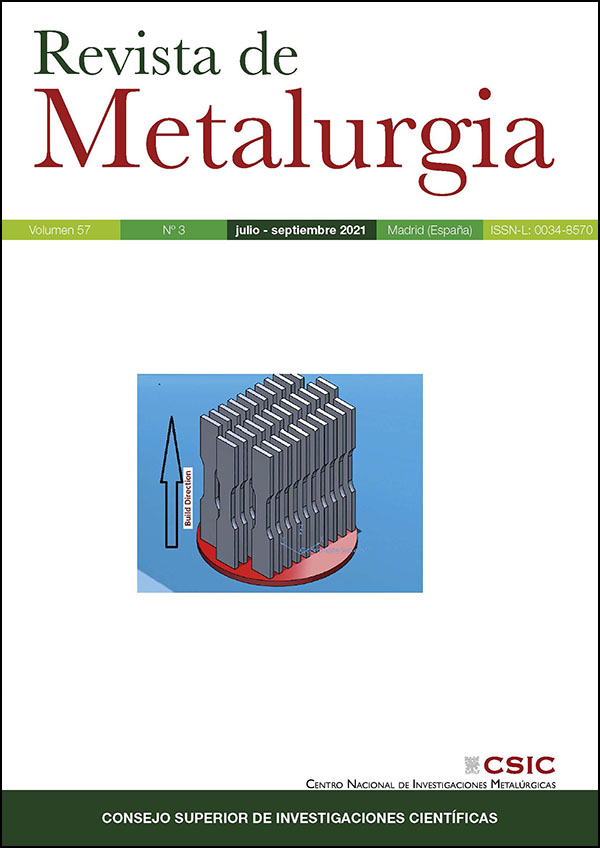Mechanical characterization of polylactic acid polymer 3D printed materials: the effects of infill geometry
DOI:
https://doi.org/10.3989/revmetalm.202Keywords:
Additive manufacturing, Infill geometry, Mechanical properties, Polylactic acid, 3D printingAbstract
Today, technological advances have led to the discovery of newly developed manufacturing methods. Additive Manufacturing technology with three-dimensional (3D) printer is one of these new methods. In this method, parts with complex geometry that cannot be produced by conventional methods can be manufactured. The most popular and low-priced method among additive manufacturing technologies is FDM (Fused Deposition Modeling). In this study, 3D printer design and manufacturing using FDM technology has been realized. Five different infill geometries such as hourglass (HG), gyroid (GY), octahedral (OC), triangle (TR) and grid (GR) have been determined, then the tensile and 3-point bending tests were applied to the manufactured Polylactic Acid polymer (PLA) samples and mechanical properties were compared with each other. The most important aspect of the study is the comparison of grid infill geometry, which has been studied extensively in the literature, and the rarely studied geometries such as hourglass, gyroid, octahedral and triangle in terms of mechanical properties. It was concluded that the different cross-section type has a significant effect, especially on tensile strength. The highest strength values were determined in the samples with triangular infill geometry.
Downloads
References
Caminero, M.A., Chacón, J.M., García-Moreno, I., Rodríguez, G.P. (2018). Impact damage resistance of 3D printed continuous fibre reinforced thermoplastic composites using fused deposition modeling. Compos. Part B-Eng. 148, 93-103. https://doi.org/10.1016/j.compositesb.2018.04.054
Chacón, J.M., Caminero, M.A., García-Plaza, E., Núñez, P.J. (2017). Additive manufacturing of PLA structures using fused deposition modelling: Effect of process parameters on mechanical properties and their optimal selection. Mater. Design 124, 143-157. https://doi.org/10.1016/j.matdes.2017.03.065
Chadha, A., Ul Haq, M.I., Raina, A., Singh, R.R., Penumarti, N.B., Bishnoi, M.S. (2019). Effect of fused deposition modelling process parameters on mechanical properties of 3D printed part. World J. Eng. 16 (4), 550-559. https://doi.org/10.1108/WJE-09-2018-0329
Durgun, I., Ertan, R. (2014). Experimental investigation of FDM process for improvement of mechanical properties and production cost. Rapid Prototyp. J. 20 (3), 228-235. https://doi.org/10.1108/RPJ-10-2012-0091
Fernandez-Vicente, M., Calle, W., Ferrandiz, S., Conejero, A. (2016). Effect of Infill Parameters on Tensile Mechanical Behavior in Desktop 3D Printing. 3D Printing and Additive Manufacturing, 3 (3), 183-192. https://doi.org/10.1089/3dp.2015.0036
Galeja, M., Hejna, A., Kosmela, P., Kulawik, A. (2020). Static and Dynamic Mechanical Properties of 3D Printed ABS as a Function of Raster Angle. Materials 13 (297). https://doi.org/10.3390/ma13020297 PMid:31936489 PMCid:PMC7013835
Jaya Christiyan, K.G., Chandrasekhar, U., Venkateswarlu, K. (2018). Flexural Properties of PLA Components Under Various Test Condition Manufactured by 3D Printer. J. Inst. Eng. India Ser. C 99, 363-367. https://doi.org/10.1007/s40032-016-0344-8
Khan, S.F., Zakaria, H., Chong, Y.L., Saad, M.A.M., Basaruddin, K. (2018). Effect of infill on tensile and flexural strength of 3D printed PLA parts. IOP Conf. Ser.: Mater. Sci. Eng. 429, 012101. https://doi.org/10.1088/1757-899X/429/1/012101
Ning, F., Cong, W., Hu, Y., Wang, H. (2017). Additive manufacturing of carbon fiber-reinforced plastic composites using fused deposition modeling: Effects of process parameters on tensile properties. Journal of Composite Materials 51 (4), 451-462. https://doi.org/10.1177/0021998316646169
Rajpurohit, S.R., Dave, H.K. (2016). Parametric studies on quality of PLA parts produced using fused deposition modeling. 6th International & 27th All India Manufacturing Technology, Design and Research Conference (AIMTDR-2016), pp. 59-62.
Rajpurohit, S.R., Dave, H.K. (2018). Flexural strength of fused filament fabricated (FFF) PLA parts on an open-source 3D printer. Adv. Manuf. 6, 430-441. https://doi.org/10.1007/s40436-018-0237-6
Rodríguez-Panes, A., Claver, J., Camacho, A.M. (2018). The Influence of Manufacturing Parameters on the Mechanical Behaviour of PLA and ABS Pieces Manufactured by FDM: A Comparative Analysis. Materials 11 (8), 1333. https://doi.org/10.3390/ma11081333 PMid:30071663 PMCid:PMC6119930
Schmitt, M., Mehta, R.M., Kim, I.Y. (2020). Additive manufacturing infill optimization for automotive 3D-printed ABS components. Rapid Prototyp. J. 26 (1), 89-99. https://doi.org/10.1108/RPJ-01-2019-0007
Sezer, H.K., Eren, O., Börklü, H.R., Özdemir, V. (2019). Additive manufacturing of carbon fiber reinforced plastic composites by fused deposition modelling: Effect of fiber content and process parameters on mechanical properties. Journal of the Faculty of Engineering and Architecture of Gazi University 34 (2), 663-674.
Wan Muhamad, W.M., Reshid, M.N., Abd Wahid, K.A., Saniman, M.N.F. (2020). Mass Reduction of a Jet Engine Bracket using Topology Optimisation for Additive Manufacturing Application. Int. J. Adv. Sci. Technol. 29 (8s), 4438-4444. http://sersc.org/journals/index.php/IJAST/article/view/25492/13653.
Wicaksono, S.T., Ardhyananta, H., Rasyida, A., Hidayat, M.I.P. (2018). Internal geometry effect of structured PLA materials manufactured by dropplet-based 3D printer on its mechanical properties. AIP Conf. Proc. 1945 (1), 020065. https://doi.org/10.1063/1.5030287
Yadav, D.K., Srivasta, R., Dev, S. (2020). Design & fabrication of ABS part by FDM for automobile application. Mater. Today Proc. 26 (2), 2089-2093. https://doi.org/10.1016/j.matpr.2020.02.451
Published
How to Cite
Issue
Section
License
Copyright (c) 2021 Consejo Superior de Investigaciones Científicas (CSIC)

This work is licensed under a Creative Commons Attribution 4.0 International License.
© CSIC. Manuscripts published in both the printed and online versions of this Journal are the property of Consejo Superior de Investigaciones Científicas, and quoting this source is a requirement for any partial or full reproduction.
All contents of this electronic edition, except where otherwise noted, are distributed under a “Creative Commons Attribution 4.0 International” (CC BY 4.0) License. You may read the basic information and the legal text of the license. The indication of the CC BY 4.0 License must be expressly stated in this way when necessary.
Self-archiving in repositories, personal webpages or similar, of any version other than the published by the Editor, is not allowed.
















